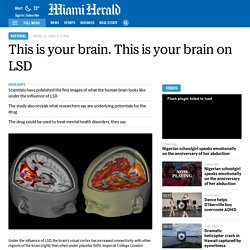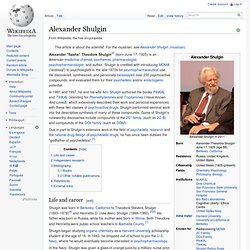

This is your brain. This is your brain on LSD. Cue the Steppenwolf, man, because we’ve got some heavy news to lay on you.

Scientists have published the first images of what the human brain looks like under the influence of LSD, one of the most powerful drugs ever created. What’s more, the new study by Imperial College London explores what researchers say are potential medical uses for the illegal psychedelic known as acid, including treating mental health disorders. Heavy, right? “For brain researchers, studying how psychedelic drugs such as LSD alter the ‘normal’ brain state is a way to study the biological phenomenon that is consciousness,” David Nutt, a neuropsychopharmacologist at Imperial College London and senior researcher on the study, told the science journal Nature. “We ultimately would also like to see LSD deployed as a therapeutic tool.” Nutt told England’s The Guardian that neuroscientists have waited 50 years for this breakthrough. “This is to neuroscience what the Higgs boson was to particle physics,” he said. Trippy. Alexander Shulgin. Alexander "Sasha" Theodore Shulgin[2] (born June 17, 1925) is an American medicinal chemist, biochemist, pharmacologist, psychopharmacologist, and author.

Shulgin is credited with introducing MDMA ("ecstasy") to psychologists in the late 1970s for psychopharmaceutical use. He discovered, synthesized, and personally bioassayed over 230 psychoactive compounds, and evaluated them for their psychedelic and/or entactogenic potential. Due in part to Shulgin's extensive work in the field of psychedelic research and the rational drug design of psychedelic drugs, he has since been dubbed the "godfather of psychedelics".[3] Life and career[edit] Shulgin was born in Berkeley, California to Theodore Stevens Shulgin (1893–1978)[4] and Henrietta D.
Shulgin began studying organic chemistry as a Harvard University scholarship student at the age of 16. In the Navy, Shulgin was given a glass of orange juice by a military nurse prior to surgery. In late 1966, Shulgin left Dow to pursue his own interests. Two new scientific studies reveal hallucinogens are good for your mental health. LSD. LSD (D-Lysergic Acid Diethylamide) is a synthetic hallucigenic drug, although it doesn't produce hallucinations but more severe distortions of the senses and thinking.

It was synthized By Albert Hoffman from Ergotamine which is found in the deadly poisonous Ergot Fungus that used to grow on crops. it gives hallucinations and gangreen. LSD's treshhold dose is 25 micrograms. Common taken doses are about 100 micrograms. It is usually taken in the form of paper blotters; small pieces of absorbant paper with some liquid LSD sprayed on them.
The effects are mood-changes, a lot of them, visual tracers, colors, synthesia, and other 'distortions' of the senses. There have been accidents on LSD, even suicides, but compared to other drugs not many at all. It was used mostly in the 60th's, untill it got made illigal and people started speading nonsense about it. Lsd is not very dangerous, its not poisionous and its LD50 is far above the user dose. Should still be used with causion. Terence McKenna on DMT and LSD. Acid compilation (LSD) BBC Horizon: Psychedelic Science - (DMT, LSD, Ibogaine)